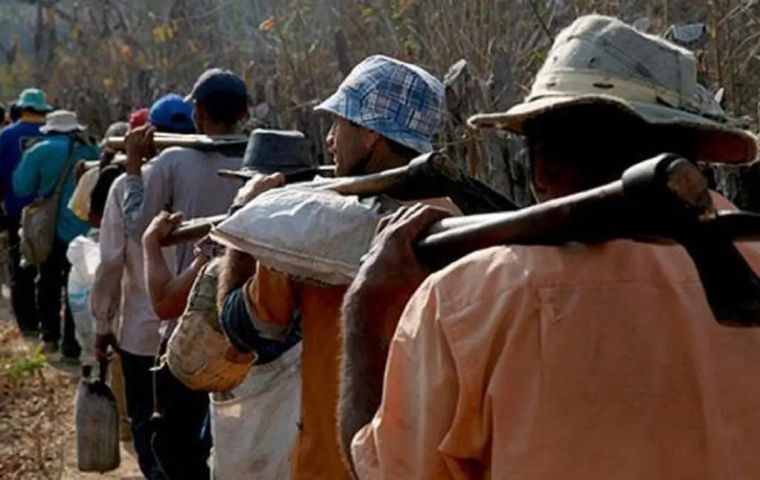MercoPress. South Atlantic News Agency
Brazil: shocking slave-like labor figures released
 Most slavery-like conditions are found in rural areas but urban cases are becoming more frequent
Most slavery-like conditions are found in rural areas but urban cases are becoming more frequent Numerous businessmen and politicians were singled out in a Labor Ministry report on slave-like working conditions in South America's largest country, released this week, singled out numerous businessmen and politicians. Over the last three decades, over 65,500 people have been rescued from such a situation. In 2024 alone, 1,035 inspections were carried out, resulting in 2,004 people being rescued, as the local feebleness of human rights was once again exposed.
According to the Labor Ministry, some 8,400 control operations since 1995 resulted in those releases. Only then did Brazil officially recognize the existence of contemporary forms of slavery. Since 2003, some US$ 26.4 million has been spent on compensation to victims. Prior to 2003, there was no accurate record, as the Rescued Worker's Unemployment Insurance (SDTR), which consists of three payments equivalent to the minimum wage, was implemented that year, it was explained.
Under Brazil's Penal Code, work analogous to slavery is that which involves forced labor, strenuous working hours, degrading conditions, or restrictions on mobility due to “debts” contracted with the employer.
In 2023, over 3,100 people were rescued from their subjugation, which was detected mostly in construction, coffee cultivation, agriculture, and horticulture. Although forced labor tends to occur in rural areas, it is also widespread in large cities, where it is detected mainly in the textile sector, which employs a greater number of women.
Brazilian authorities created in 2004 the so-called “dirty list” of slave labor, where people and companies imposing those conditions on others were included as a warning to potential victims. The United Nations (UN) deemed that initiative a key tool in the fight against modern-day slavery.
Inclusion on the slave labor list is not a judicial sanction, but a transparency tool for society to know which companies and individuals have been identified as exploiting people in degrading conditions, it was explained.




Top Comments
Disclaimer & comment rules-

-

-

Read all comments“Le plus ça change...”
Feb 01st, 2025 - 08:43 pm +1Bras, for the first part of your post you talked some sense, but then you drifted off again spouting your communist clap trap, its not capitalist that are exploiting them , but nasty criminals, who come in all forms, shapes and sizes, one day you might post something that resembles the truth and reality,
Feb 04th, 2025 - 04:15 pm +165,500 people were rescued from slave-like labor in 30 years, it was reported. This gives an average of 2,183 people freed each year.
Feb 01st, 2025 - 11:04 am -1If we consider that there are 500,000 Bolivians living in São Paulo, half of whom are (still) illegally, and that 30,000 of them are still enslaved by their own compatriots, I believe that there is still a lot of work to be done by the inspectors.
It should also be considered that the deterioration of living conditions in Argentina has caused a significant increase in the immigration of Argentine nationals to Brazil, in conditions that are often degrading. Recently, Argentines were freed from slave-like labor in the South of Brazil.
I will not even mention our Venezuelan brothers, who already number 1 million immigrants here. I am convinced that many of them are exploited by capitalists who are enemies of the human species. It is necessary to increase the number of inspectors fivefold so that we can free our brothers and severely punish those who degrade human life.
https://agenciabrasil.ebc.com.br/radioagencia-nacional/direitos-humanos/audio/2025-01/argentinos-sao-resgatados-de-situacao-semelhante-escravidao-no-rs#:~:text=Quatro%20argentinos%2C%20com%20idades%20entre,do%20Rio%20Grande%20do%20Sul.
Commenting for this story is now closed.
If you have a Facebook account, become a fan and comment on our Facebook Page!